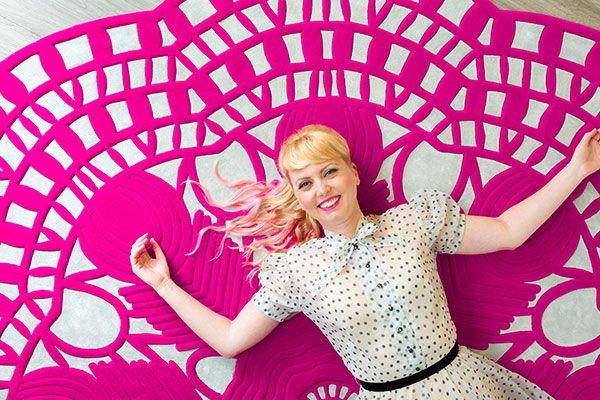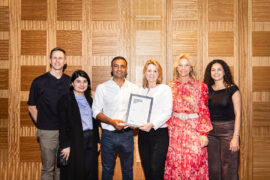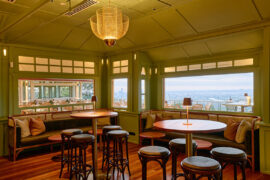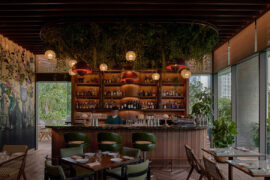Western Australia has joined the European Space Agency’s exploration of Mars. Here, we investigate the influence of outer space on A+D.
November 18th, 2016
In 2003, the European Space Agency (ESA) opened its first deep space ground station in New Norcia, Western Australia. Today, the station is playing an important role in the ESA’s search for evidence of life on Mars, being a main communication point between Earth and the ExoMars Schiaparelli Module – an entry, descent and landing demonstrator module that has been designed to assess the surface of the red planet.
New Norcia is a small monastic community located 130 kilometres north of Perth, and now scientists and aerospace engineers from all over Australia and the world come to the tracking station for programs, briefings and behind-the-scenes tours. As an initiative that will only drive Western Australia’s scientific community forward it prompted me to think about how space has influenced architecture and design in the past, and how it might inspire it in the future.
Outer space and intergalactic travel has been part of our collective imagination since the days of the “space race” in the 1950s and 60s when the USA and USSR engaged not only in the Cold War, but a technological and scientific battle to reach the moon first. The Soviet Union launched the Sputnik satellite in 1957 – the first satellite to orbit the moon – and the United States established NASA in response and put a man on the moon in 1969.
The Space Age, as it became known, infiltrated all forms of culture and design and has since continued to provide inspiration for designers and design thinkers. In 1968, Stanley Kubrick’s 2001: A Space Odyssey followed a voyage to Jupiter and envisioned the future not only of spaceflight, but also of design innovation. The film team invited manufacturers and designers, including IBM, Honeywell, Dupont, Nikon, Parker Pens, amongst others, to project how their products might look in 2001; the most prominent in our imagination being Olivier Mourgue’s curving red Djinn chair.
Indeed, the spacecraft – with its rocket exterior and capsule interior – came to inform architecture and design with futuristic, experimental and organic forms, and promoted new and unconventional ways of living. Eero Aarnio’s Ball Chair (1965) had the geometry of a space helmet with an enclosed and isolating form; Verner Panton’s Living Tower (1968–70) was a sculptural cave for sitting, lying, relaxing and sleeping; and Joe Colombo’s Roto-Living System (1970) offered a space-age solution to compact living with new materials, forms and technologies.
In architecture, John Lautner’s Chemosphere hovered like a flying saucer in the Hollywood Hills, and Eero Saarinen’s Gateway Arch suggested movement through time and space. Back on home territory, Roy Grounds designed the Australian Academy of Science (1959) in Canberra, rendering it as one of the country’s most radical examples of modernism and of space age design. Also known as the Shine Dome, it draws on classical elements, such as arches and arcades, while having a distinctly futuristic vision.
Today, the space age spirit can be seen in Zaha Hadid’s Dominion Office Building in Moscow, which has seamless and sculptural white forms reminiscent of Kubrick’s masterpiece; and LAVA’s aptly named Future Hotel project in Germany is an architectural space that like Colombo’s Roto-Living has “tomorrow’s” technology, and like Panton’s Living Tower offers a fluid interface with the human body.
The Space Age certainly continues to inspire form: Marc Newson, admittedly captivated by the The Jetsons, applies a streamlined aesthetic to furniture and objects; Spanish brand Sancal has taken a retrofuturistic approach for its most recent collection and envisioned the future of design through a 1960s lens; and Doshi Levien designed ‘Rocket,’ a new curtain fabric for Kvradat with a science fiction feel.
It could also be considered to continue to inform function, particularly when it comes to compact apartment living and the efficient use of technology and space. Sydney designer Nicholas Gurney, for example, redesigned his 27 square metre studio with a joinery pod and sliding panel that demonstrates the need for clever space-saving design.
Space was “the final frontier,” as William Shatner narrates in Star Trek. Indeed, the frontier has always loomed large in the popular imagination: America conquered the western frontier in the 1800s; and President John F. Kennedy described the 1960s as the “new frontier.” So as we get one step closer to discovering whether there is life on Mars, will the possibilities of space continue to inspire our futurist visions? It does seem the 1960s still inform the popular imaginary of space, so perhaps our futurist visions now lay in another frontier. One of seemingly infinite possibility: The Information Age and beyond.
INDESIGN is on instagram
Follow @indesignlive
A searchable and comprehensive guide for specifying leading products and their suppliers
Keep up to date with the latest and greatest from our industry BFF's!

A longstanding partnership turns a historic city into a hub for emerging talent
The new range features slabs with warm, earthy palettes that lend a sense of organic luxury to every space.

Welcomed to the Australian design scene in 2024, Kokuyo is set to redefine collaboration, bringing its unique blend of colour and function to individuals and corporations, designed to be used Any Way!

For Aidan Mawhinney, the secret ingredient to Living Edge’s success “comes down to people, product and place.” As the brand celebrates a significant 25-year milestone, it’s that commitment to authentic, sustainable design – and the people behind it all – that continues to anchor its legacy.

Designed in partnership with Petrina Turner Design, New Again is a collection of four hand-tufted rugs referencing family memories.
The finalists for the Bombay Sapphire Design Discovery Award have been announced.
The internet never sleeps! Here's the stuff you might have missed

The winners of two major Powerhouse design initiatives – the Holdmark Innovation Award and the Carl Nielsen Design Accelerator – have been announced with the launch of Sydney Design Week 2025.

Piers Taylor joins Timothy Alouani-Roby at The Commons to discuss overlaps with Glenn Murcutt and Francis Kéré, his renowned ‘Studio in the Woods,’ and the sheer desire to make things with whatever might be at hand.

A multi-million dollar revitalisation of the heritage-listed venue at Brisbane’s beauty spot has been completed with The Summit Restaurant.

Grounded by the rich warmth of American white oak, The Standard’s newly opened restaurant, Kaya, redefines the classic dining convention through a tasteful fusion of biophilic design, mid-century modern sensibility and elevated whimsy.